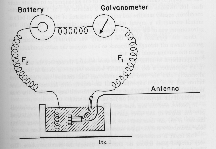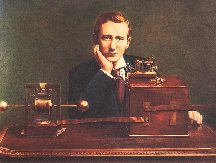



|
|
| Tuesday, September 21, 2004 | |
| NRAO Home > What is Radio Astronomy? > History > Prehistory |
The prediction of electromagnetic waves by Maxwell and the demonstration of their existence by Hertz led several scientists to speculate that celestial objects, such as the Sun and stars, might generate radio waves. The following scientists set the groundwork for the later discovery of radio astronomy. Click on each one for a summary of his contibutions.
James Clerk Maxwell (1831-1879)
Read more about Maxwell. (from Univ of St.Andrews, Scotland)
Heinrich Hertz (1857-1894)
Read more about Hertz (and other pioneers of electronics)
Thomas Alva Edison (1847-1931)
Letter reproduced from "The Evolution of Radio Astronomy", by J.S.Hey,
Science History Publications, 1973. See also: C.D.Shane, Pub.Astron. Soc. Pacific 70,303, 1958.
Sir Oliver J. Lodge (1851-1940)
Letter reproduced from "Classics in Radio Astronomy", by W.T.Sullivan, Reidel, 1982. Original in Lodge: "Signalling across space without wires", The Electrician Publ.Co., London, 1900. Wilsing and Scheiner (1896)
Charles Nordman (1900) Charles Nordman, a French graduate student, reasoned that if radio waves were being absorbed
by the atmosphere, as Wilsing and Scheiner thought, the solution would be to go to high altitude.
He set up a long wire antenna on a glacier on Mont Blanc, at about 3100m (about 10,000 ft).
In hindsight we know that the antenna would have been sensitive to low frequency radio bursts
from the Sun and would have been capable of detecting them. These bursts occur most often
during Solar maxima, but unfortunately the Sun was at Solar miniumum in 1900.
Again there was no detection.
Nordman's experiment was published in Comptes Rendus Acad.Sci., vol.134, page 273, 1902.
(Reprinted in English in "Classics in Radio Astronomy" by W.T. Sullivan,
Reidel, 1982).
Charles Nordman, a French graduate student, reasoned that if radio waves were being absorbed
by the atmosphere, as Wilsing and Scheiner thought, the solution would be to go to high altitude.
He set up a long wire antenna on a glacier on Mont Blanc, at about 3100m (about 10,000 ft).
In hindsight we know that the antenna would have been sensitive to low frequency radio bursts
from the Sun and would have been capable of detecting them. These bursts occur most often
during Solar maxima, but unfortunately the Sun was at Solar miniumum in 1900.
Again there was no detection.
Nordman's experiment was published in Comptes Rendus Acad.Sci., vol.134, page 273, 1902.
(Reprinted in English in "Classics in Radio Astronomy" by W.T. Sullivan,
Reidel, 1982).
These unsuccesful attempts at finding solar radio waves may have discouraged further
experiments. But it is also possible that the theoretical breakthroughs by Planck and
Heaviside may have played a role.
Max Planck (1858-1947)
It was known that when dense objects are heated to high temperatures, they radiate energy, and that the graph of intensity versus wavelength followed a curve such as is illustrated here. The higher the temperature, the shorter the wavelength of the peak of the curve. Planck worked out how to derive this thermal radiation curve from a theory of absorption and emission of radiation by matter. The theory required that energy had to be emitted or absorbed in small packets, or "quanta" of energy. This was a breakthrough in Physics and led to further development of the quantum theory to explain all electro-magnetic phenomena.
The spectrum of light from the Sun very closely resembles a thermal radiation curve.
If one applies Planck's theory to predict the amount of radiation we might receive
from the Sun in the radio part of the spectrum (wavelengths in the 10 to 100 cm range),
the radiation would be very weak: much too weak to be detected by any receiver
available around 1900. This theoretical prediction, along with the failure of
experiments to detect the Sun, may have discouraged further attempts.
Read more about Planck. (from Univ of St.Andrews, Scotland)
Oliver Heaviside (1850-1925)
If radio waves bounce off the inside of the ionosphere, then they must also bounce off the outside. So any radio waves from outside the earth would not get through to the ground -- they would bounce back into space. Thus the predictions by Heaviside, combined with Planck's radiation theory, probably discouraged further attempts to detect radio waves from the Sun and other celestial objects. For whatever reason, there seem to have been no attempts for 30 years, until Jansky's unexpected discovery in 1932. Later it was learned that the reflection from the ionosphere is very dependent on the frequency (or wavelength). It reflects most of the radiation of frequency less than about 20 MHz. But the ionosphere is not a barrier to frequencies above about 50 MHz. Radio astronomy had to wait for the development of high frequency radio receivers.
Read more about Heaviside. (from Univ of St.Andrews, Scotland)
Guglielmo Marconi (1874-1937) Marconi improved radio transmission and receiver designs and developed the first
practical systems for long distance communication by radio. In 1901 he was the first
to send and receive signals across an ocean, from Newfoundland to Cornwall.
As a result of his pioneering efforts, commercial radiotelephone service became available
in later years.
In the 1930s the Bell Telephone
company was working on improving their transatlantic telephone service when they assigned
Karl Jansky to investigate sources of radio static, leading to his discovery of radio
waves from the milky way.
Marconi improved radio transmission and receiver designs and developed the first
practical systems for long distance communication by radio. In 1901 he was the first
to send and receive signals across an ocean, from Newfoundland to Cornwall.
As a result of his pioneering efforts, commercial radiotelephone service became available
in later years.
In the 1930s the Bell Telephone
company was working on improving their transatlantic telephone service when they assigned
Karl Jansky to investigate sources of radio static, leading to his discovery of radio
waves from the milky way.
Some Biographies of Marconi:
Credits: Pictures of Maxwell, Planck, Heaviside: School of Mathematics and Statistics, University of St.Andrews, Scotland. [http://www-history.mcs.st-and.ac.uk/history/Mathematicians/] Maxwell's equations: Halliday and Resnick, "Physics for Students of Science and Engineering", Wiley 1962. Hertz: from "Astronomy" by Fred Hoyle, Crescent Books, 1962. Edison: from K-12 Teaching and Learning Center web site: [http://tlc.ai.org/edison.htm], Also the Franklin Institute [http://sln.fi.edu/franklin/inventor/edison.html] Planck radiation curves diagram from Chaisson and McMillan, "Astronomy, a Beginners Guide to the Universe", Prentice Hall, 1998. Lodge: IEE/DERA, www.dera.gov.uk/iee/lodge.jpg; and das-fotoarchiv.com/lautspre/erfinder.jpg. Compiled by F. Ghigo, National Radio Astronomy Observatory, Green Bank, West Virginia. 
Home | Contact Us | Directories | Site Map | Help | Privacy Policy | Search Modified on Thursday, 27-Mar-2003 12:20:35 MST |